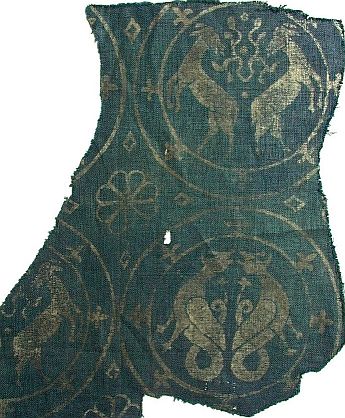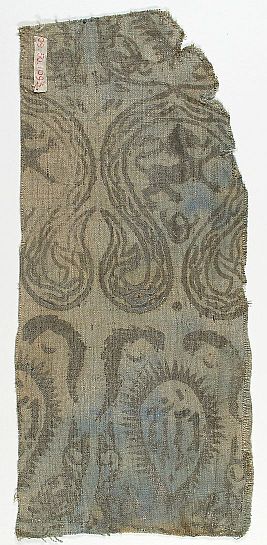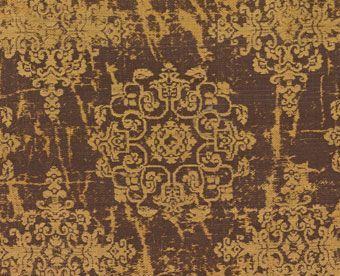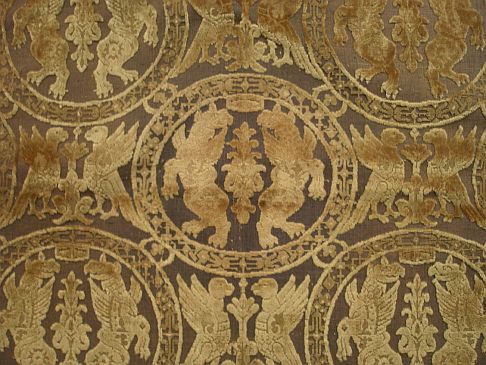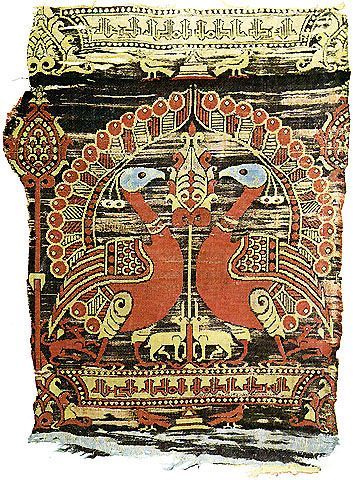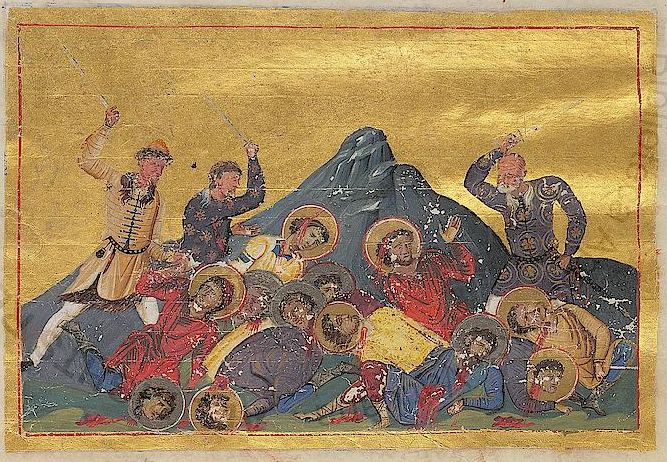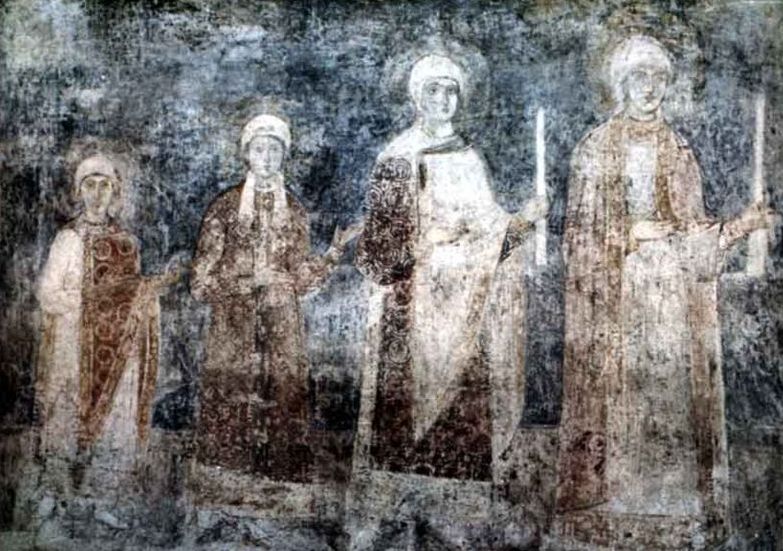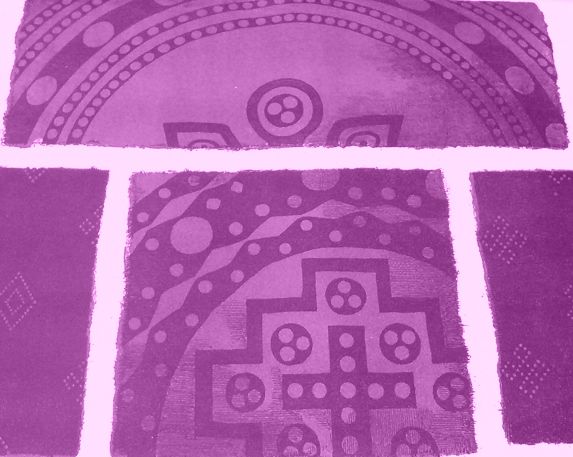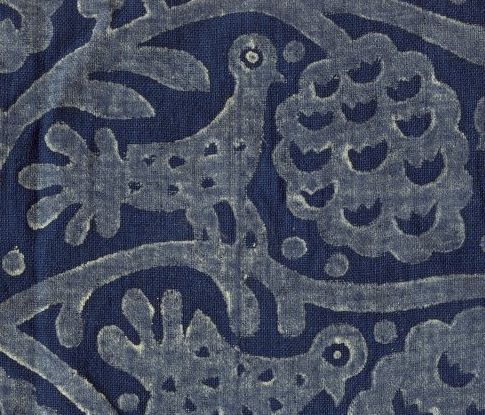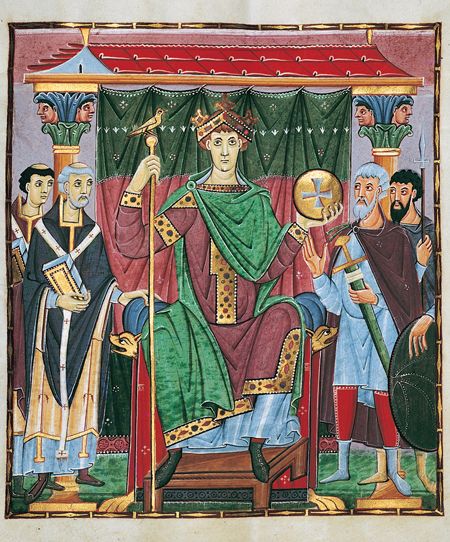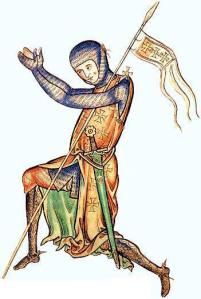BLOCK PRINTED FABRIC AND VIKINGS
|
Does the recent fashion for reenactors to sport block-printed textiles have any basis in historical fact?
I have been 'reliably' told that evidence exists for block-printed fabric from Gotland or from 'certain graves'. This is bollocks – whoops just spelt 'blocks' wrongly. On purpose. Block printing is the use of dyes applied to a carved wooden block and then pressed onto cloth to transfer the design. Block printing was developed in China in and used for books but not developed for cloth decoration. They had silk available for the elite to show their wealth. Other fabrics did not come close in status to be worth decorating so much as brocaded silk. There are many examples from 12 to 15th century of block printing on linen but nothing from 11th century and nothing from 'Viking' areas.
The examples found are very much simpler than the woven silk originals and on linen. India was the source for printed fabrics in Europe, starting with the activities of traders in the 17th -18th century. Woven silk fabrics originated in China and then Persia. The techniques arrived in the Mediterranean area in the eleventh to twelfth centuries. It was a highly prized technology and carefully guarded. Patterned silk cost more than its weight in gold. Example to right is silk brocade of 12th century from Spain. |
From Wikipedia 'Wood-block Printing on Textiles'...
Museum specimens establish the fact that more important pattern printing on textiles had become a developed industry in parts of Europe towards the end of the 12th and the beginning of the 13th century. Between the 11th and 14th centuries there was apparently in Germany no such weaving of rich ornamental stuffs as that carried on in Spain and Italy, but her competitive and commercial instincts led her to adapt her art of stamping to the decoration of coarse textiles, and thus to produce rather rough imitations of patterns woven in the Saracenic, Byzantine and Italian silks and brocades. From Wikipedia..'Textile Printing'...
Textile printing was known in Europe, via the Islamic world, from about the 12th century, and widely used. However, the European dyes tended to liquify, which restricted the use of printed patterns. Fairly large and ambitious designs were printed for decorative purposes such as wall-hangings and lectern-cloths, where this was less of a problem as they did not need washing. When paper became common, the technology was rapidly used on that for woodcut prints.[1] Superior cloth was also imported from Islamic countries, but this was much more expensive. In " Il libro dell'arte" written by Cennino Cennini in the early 15th century as the proof of the existence of block printing in Italy in the early Renaissance. However, the editions of that book by Tambroni and the Milanesi (chapter CLXXIII) have a very basic and unconvincing account of the process. |
This picture is an illumination from the synaxarion of Basil II – also called the the menologion of Basil II. This is sometimes used to show 'viking / Rus ' style. The decorated tunics are obviously meant to be costly patterned - brocaded - silk. This clothing contrasts with that of the dying Romans and enhances the exoticism and asiatic identity of the Bulgars.
It was compiled in Constantinople c. 1000AD. It is a liturgical work, used in church services.
A digital version is online from the Vatican _ here
The illumination itself shows Bulgars killing Byzantine Christians. Just what this has to do with Viking, with people in northern Europe, is hard to see.
Throughout this manuscript are depictions of oppressors killing Christians – it is largely a list of martyrdoms and the Saints' feast days. There are eight different artists.
This MS could be a source for Roman dress of the time. It could be a source for Bulgar dress but we do not know if the artists saw Bulgar dress at first hand. It is perverse to think it is evidence for Viking dress, even Rus dress - Rus being Swedes who had spent some time in what is now Russia - maybe were born there.
This significant detail apart, the work is dated to c.1000AD. This places its possible influence to the latest era of 'viking' activity. Nothing from earlier times should be combined with it.
It was compiled in Constantinople c. 1000AD. It is a liturgical work, used in church services.
A digital version is online from the Vatican _ here
The illumination itself shows Bulgars killing Byzantine Christians. Just what this has to do with Viking, with people in northern Europe, is hard to see.
Throughout this manuscript are depictions of oppressors killing Christians – it is largely a list of martyrdoms and the Saints' feast days. There are eight different artists.
This MS could be a source for Roman dress of the time. It could be a source for Bulgar dress but we do not know if the artists saw Bulgar dress at first hand. It is perverse to think it is evidence for Viking dress, even Rus dress - Rus being Swedes who had spent some time in what is now Russia - maybe were born there.
This significant detail apart, the work is dated to c.1000AD. This places its possible influence to the latest era of 'viking' activity. Nothing from earlier times should be combined with it.
BLOCK PRINTING AND SILK
The early block printing was supposedly in imitation of patterned silk brocades originating from Asia and which were produced from 11th century in the Mediterranean areas.
Again, perversely, illustrations of figures in what would have been intended to be costly silk fabrics are used as justification for using block-printed fabrics. Think a moment – because silk fabric is shown ( and the figures shown are intended to be dressed in very costly dress appropriate to their status ) therefore it is ok to use a cheap copy of it. This is no support.
Block-printing is for linen and cotton. Not usually wool. Wool was the fabric of choice for people in a northern european climate.
The early block printing was supposedly in imitation of patterned silk brocades originating from Asia and which were produced from 11th century in the Mediterranean areas.
Again, perversely, illustrations of figures in what would have been intended to be costly silk fabrics are used as justification for using block-printed fabrics. Think a moment – because silk fabric is shown ( and the figures shown are intended to be dressed in very costly dress appropriate to their status ) therefore it is ok to use a cheap copy of it. This is no support.
Block-printing is for linen and cotton. Not usually wool. Wool was the fabric of choice for people in a northern european climate.
|
This 11th century fresco in Kiev cathedral shows the daughters of Yaroslavl. They wear patterned cloth. The patterns resemble eastern silks. It is a magnitude of improbability greater to suggest what is actually shown is intended to be block-printed fabric which is intended to imitate costly patterned silk.
|
FINDS IN THE RUSSIAN AREA
Levenko-Starodub: dug in 1874. The grave mounds of Sami related people of the lands known as Severia, north-east of Kiev. In a woman's grave here were many tiny fragments of a wool which was purple tha had printed patterns and embroidery on it in black . The excavator and researchers gave it a Byzantine origin.
The dating was first suggested as IX to X century but is revised to XI to XII century. The poverty of grave goods makes dating difficult.
This cloth was likened to the materials shown on the Kiev fresco.
A fragment of red silk with a green pattern was found in an 11th century mound at Gnezdovo near Smolensk. The big argument around Gnezdovo is 'how native were the inhabitants?'Were they a Swedish outpost in the process of going native or were they natives with a penchant for exotic stuff?. The cloth is considered to have originated in Byzantium. These fragments are enigmatic and I will put up more about them asap.
(Thanks to Mitja 'Venäläinen' for info)
Neither find is from a 'Viking' in a 'Viking' area. Gnezdovo has also produced Chinese and Iranian dresses but I have not noticed 'Viking' reenactors rushing to wear them.
There is more to read at the website of KAUP, the Baltic Living History Society. Their site is a mine of information about eastern Baltic peoples of the Viking Age.
Levenko-Starodub: dug in 1874. The grave mounds of Sami related people of the lands known as Severia, north-east of Kiev. In a woman's grave here were many tiny fragments of a wool which was purple tha had printed patterns and embroidery on it in black . The excavator and researchers gave it a Byzantine origin.
The dating was first suggested as IX to X century but is revised to XI to XII century. The poverty of grave goods makes dating difficult.
This cloth was likened to the materials shown on the Kiev fresco.
A fragment of red silk with a green pattern was found in an 11th century mound at Gnezdovo near Smolensk. The big argument around Gnezdovo is 'how native were the inhabitants?'Were they a Swedish outpost in the process of going native or were they natives with a penchant for exotic stuff?. The cloth is considered to have originated in Byzantium. These fragments are enigmatic and I will put up more about them asap.
(Thanks to Mitja 'Venäläinen' for info)
Neither find is from a 'Viking' in a 'Viking' area. Gnezdovo has also produced Chinese and Iranian dresses but I have not noticed 'Viking' reenactors rushing to wear them.
There is more to read at the website of KAUP, the Baltic Living History Society. Their site is a mine of information about eastern Baltic peoples of the Viking Age.
|
THE SURCOAT Very costly fabrics of silk do not do well when worn beneath armour. Besides, the audience cannot see it. Fighting men in the middle east have long had the problem that is gets hot, and armour gets even hotter in that climate. The answer was to wear a looser garment over the armour to block the sunlight and allow air-flow over the surface. This garment became known in the west as a surcoat and was adopted after the First Crusade of 1095AD as a suitable field for displaying heraldic motifs also. The use of silk surcoats by 'Viking warriors' – what can one say ? Wrong place, wrong time, wrong garment, wrong material, WRONG. |
BLOCK PRINTING AND RUSSIA
Block printing has has a rich history in Europe. Mainly since the arrival of cotton fabrics from the 1600s onwards. Simple geometric printing could liven up plain, cheap cotton. In Russia there has been, since the 1700s, a lively tradition of block-printed cloth - naboika. In Russian Folk Art by Alison Hilton (Indiana 1995)she considers the oldest block printing to be from then. The designs are based on folk-art chip carving patterns. Entire villages became known as skilled cloth printers and this traditional craft has been very strong in Russia until the twentieth century. Most peasant women owned their own printing boards and oil-based paint hammered-down with a mallet,and resist-dying with glue-based paints known as vapa. The revival of this old-time art form, which is beautiful in itself, is no justification for using it in Viking reenactment. EUROPEAN ILLUMINATIONS
In the west of the 10th and 11th century there is a rich tradition of illuminated manuscripts, especially in Ottonian Saxony. If block-printed cloth was around in quantity it would surely be represented there ? It is not. There are embroidered borders and collars but no cloths covered in patterning which could be block printing (or, more likely, silk). In the Viking areas, of course , we have no similar resource, but also, no textile remains to support print-patterned cloth. In fact, in Viking Age chronicles military men are described as being iron-clad or 'mailed' and the display of the armour is more impressive than any cloth they wear. |
THE BOTTOM LINE
Reenactment is about representing the past for a modern audience and to find out something about what it was like as a human being to use the material culture of the past.
If I want to reenact 18th century France it is perverse to dress as someone from 12th century China – despite my protestations that there were Chinese imports to France. If I want to reenact Vikings I must seek materials from the Viking homelands rather than other places at a similar time.
Reenactment does not allow one to dislocate time and place. If one does that then it is not reenactment. Ignorance can be countered by information. With time we all get 'better' or 'more accurate'.
Some of the happiest people I know resemble kleptomaniacs who have just run riot in the stores of a large museum. I cannot forgive them for they should damn well know what they do.
Reenactment is about representing the past for a modern audience and to find out something about what it was like as a human being to use the material culture of the past.
If I want to reenact 18th century France it is perverse to dress as someone from 12th century China – despite my protestations that there were Chinese imports to France. If I want to reenact Vikings I must seek materials from the Viking homelands rather than other places at a similar time.
Reenactment does not allow one to dislocate time and place. If one does that then it is not reenactment. Ignorance can be countered by information. With time we all get 'better' or 'more accurate'.
Some of the happiest people I know resemble kleptomaniacs who have just run riot in the stores of a large museum. I cannot forgive them for they should damn well know what they do.
